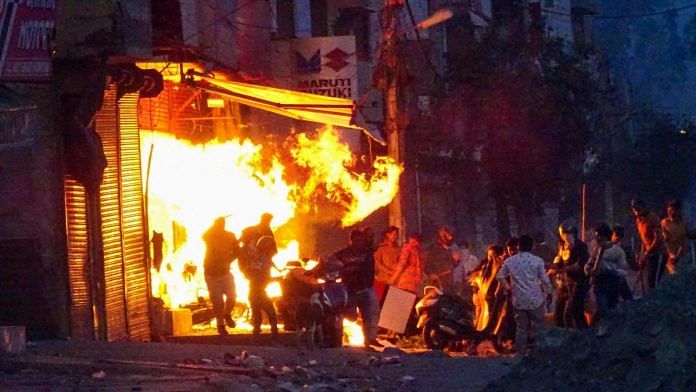New Delhi: The Delhi Police Wednesday filed its charge sheet in a special court against 15 people in the Northeast Delhi riots case, and claimed that the main aim of the “key conspirators” was not to hold a chakka jam (blockading a road) protesting the Citizenship Amendment Act, but to “engineer a riot” and “ensure communal skirmish”.
It accused the 15 people — Tahir Hussain, Mohd Parvez Ahmed, Mohd Illyas, Saifi Khalid, Ishrat Jahan, Meeran Haider, Safoora Zargar, Asif Iqbal Tanha, Shahdab Ahmed, Natasha Narwal, Devangana Kalita, Tasleem Ahmed, Saleem Malik, Mohd Saleem Khan and Athar Khan — of a larger conspiracy behind the February riots.
The police charge sheet said the anti-CAA protests were planned and the organisers engineered the riots to bring a “bad name to the government”. It alleged that the core committee — key members of which were Umar Khalid, Sharjeel Imam, Safoora Zargar, the Pinjra Tod collective as well as the Popular Front of India — held a series of meetings planning the protests, and also discussed possible consequences of thee plan, including the possibility of riots and violence. But they still went ahead with it, the police stated, adding that this is “evidence” to justify booking the accused in a case of conspiracy.
The Delhi Police also claimed to have analysed a series of WhatsApp chats from groups that were formed in December 2019 and remained active in February.
Deputy Commissioner of Police (special cell) Pramod Kushwaha informed the court how WhatsApp groups, including ‘Delhi Protest Support Group’, “mobilised crowds and carried out violence”.
The court was also informed that a text message has been retrieved, which showed protesters were intentionally carrying out violence in Seelampur and Jafrabad areas of Northeast Delhi.
Also read: A legal breakdown of the BJP’s four controversial arguments in defence of CAA
Purpose of chakka jam was to ensure communal skirmish
According to the charge sheet, the “key executors” made sure that the protesters moved from various parts of Northeast Delhi to the ‘66-foot road’ at Jafrabad Metro Station on the night of 22 February, completely blocking the traffic, to “ensure communal skirmish”.
“These blockade points were so chosen that a coordinated simultaneous blockade of traffic would lead to a complete paralysis of traffic in a large part of the city,” a police source said.
“The intent was not to create traffic chaos, but to ensure communal skirmish,” the source said, adding that this was evident because the protests were moved from “24×7 sit-in dharnas in predominantly minority clusters” to “areas of mixed population”.
The source said in “pursuance and furtherance of common conspiracy”, on 23 February, the conspirators from other protest sites in Northeast and other parts of Delhi moved from the protest sites to “pre-decided points” on important roads and blocked traffic completely, which were to be followed by “engineered riots”.
“As part of the conspiracy, this chakka jam was to be followed up by the engineered riots involving attack on police personnel and attack on non-Muslim population and damage and destruction of government property and public property by arson, vandalism and other means,” the source said.
Also read: CAA protesters’ arrest ‘designed to send chilling message’: UN asks India to free activists
Protesters gathered at 66-foot road to see police response
According to the police, as part of the conspiracy, on the night of 22 February, people from other protest sites of Northeast Delhi visited the site of the chakka jam at Jafrabad Metro Station to “learn the modus operandi of chakka jam from a live chakka jam spot”, and to “assess the response and response mechanism of police”.
“From 23 February, the conspirators from various protest sites, in a coordinated manner, moved from these protest sites and completely blocked the traffic at pre-designated spots on main roads,” the source said.
According to the source, protesters from the Chand Bagh Mazaar protest site moved and occupied the main road near the mazar, and caused a chakka jam on Wazirabad-Ghaziabad road. Then, those from the protest site at Farukhiya Masjid-Brijpuri Puliya moved and caused a blockade at Brijpuri T-point on the Wazirabad-Ghaziabad Road. Those from the Ashrafi Masjid Kardampuri Puliya caused another chakka jam at a T-point on the 66-foot road, while those from the Badi Masjid Khureji protest site blocked the main Patparganj road.
“Post the chakka jam, the protesters executed attacks on police personnel and non-Muslims and caused extensive damage to government property and private property by arson, vandalising and other means in these so-engineered riots,” the source said.
“Fire-arms, petrol bombs, acid attacks, sharp-edged weapons, iron rods, sticks, and stones — through pre-fabricated large slingshots and other means — were used for attacking and killing police personnel, government employees and public personnel,” the source said.
Also read: HC refuses to drop dacoity charges against anti-CAA protestor for ‘stealing’ keys of state bus




Well, when one thought they can’t fall lower still, they have a habit of surprising you. But then what else can one expect with a consigliere getting the charge of the law enforcement.
In these sub continent there are 3 countries we can take as
Example pakistan and Bangladesh and Afghanistan what happened to HINDUS who were in minority
Now lets take an example of Kashmir as to what happens to HINDUS when in minority
Now imagine INDIA also had HINDUS in minority
HINDUS believe in education and science and prosperity of all .
HINDUS want to live in peace but will not take fake news and propaganda against them at face value and will question such fake propaganda on SOCIAL MEDIA.